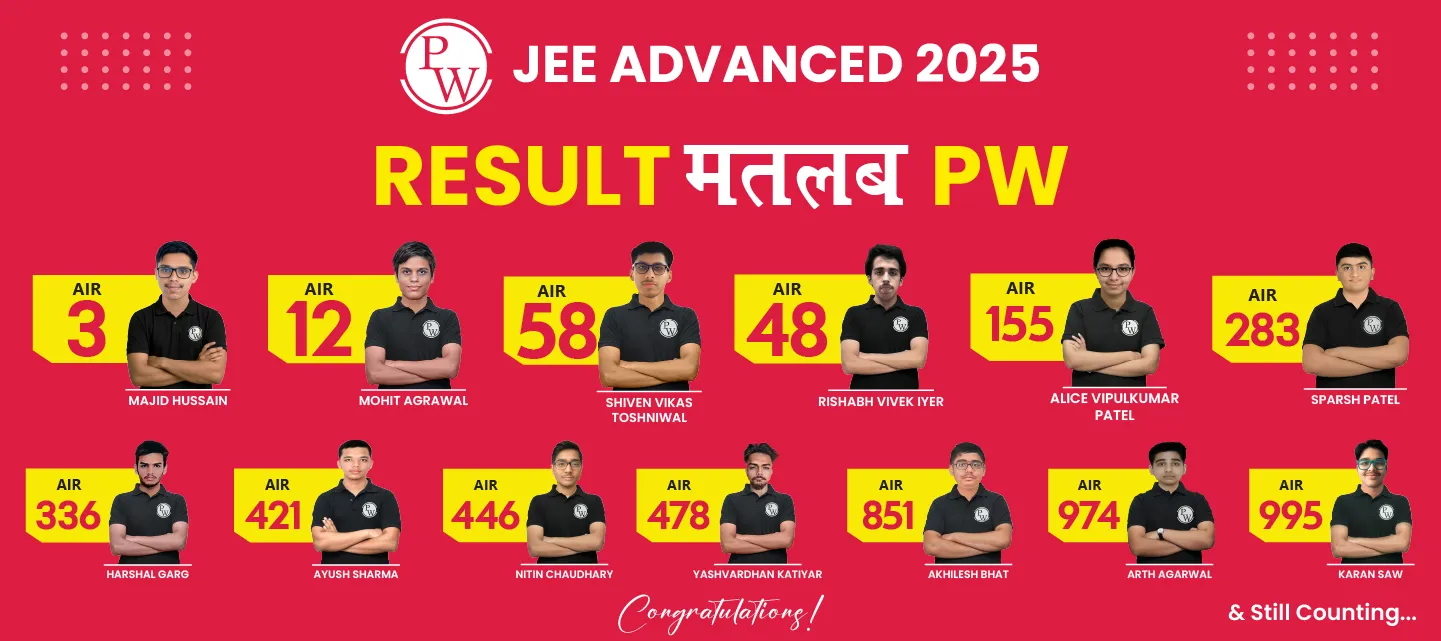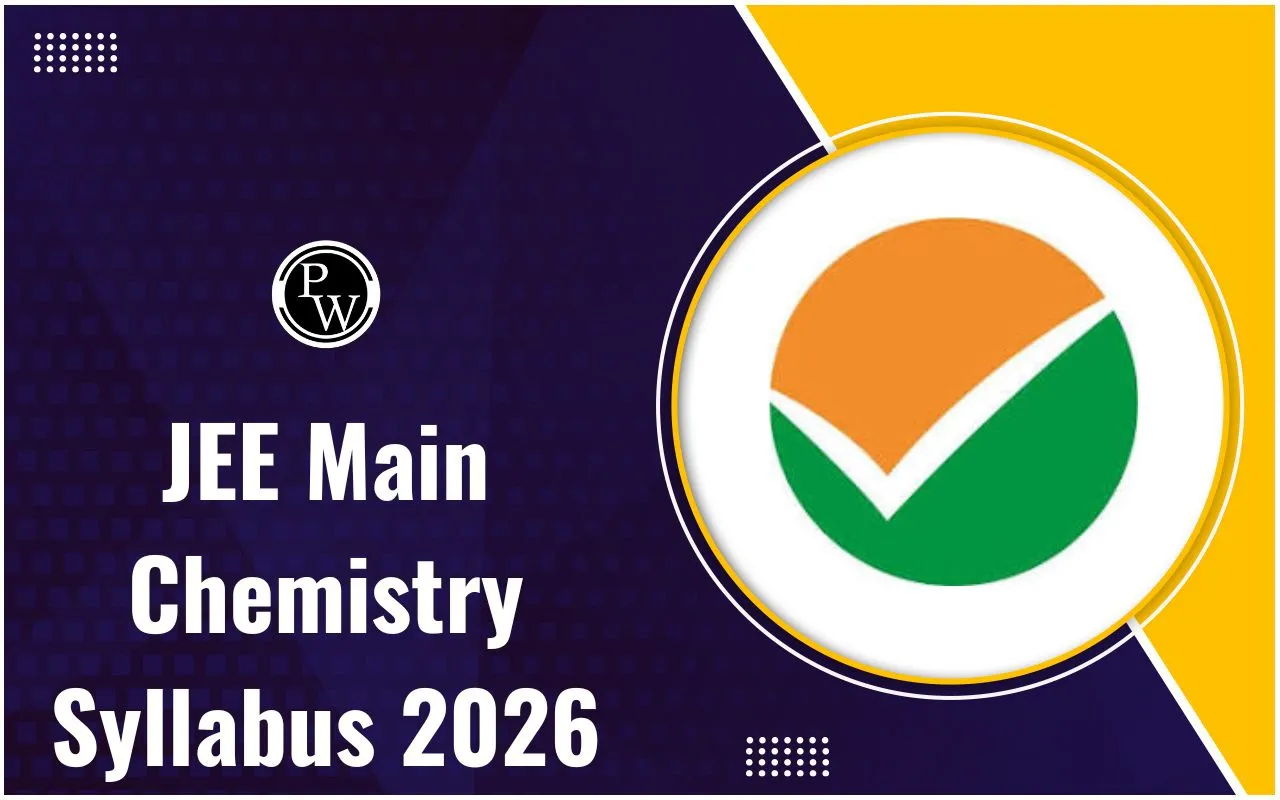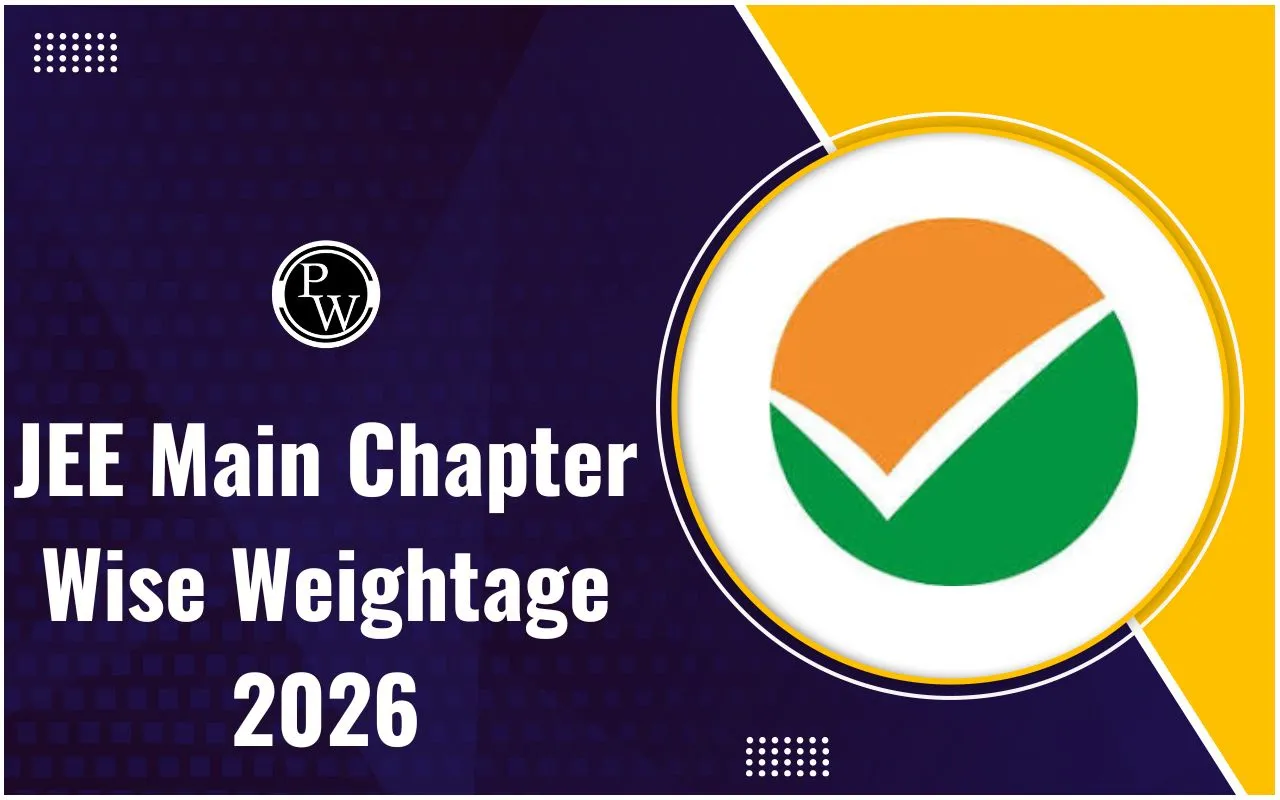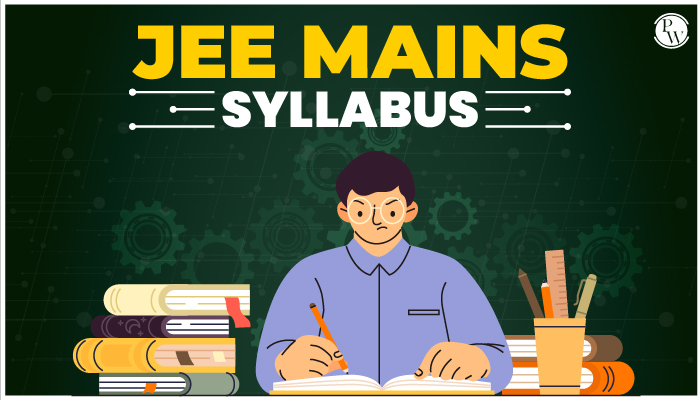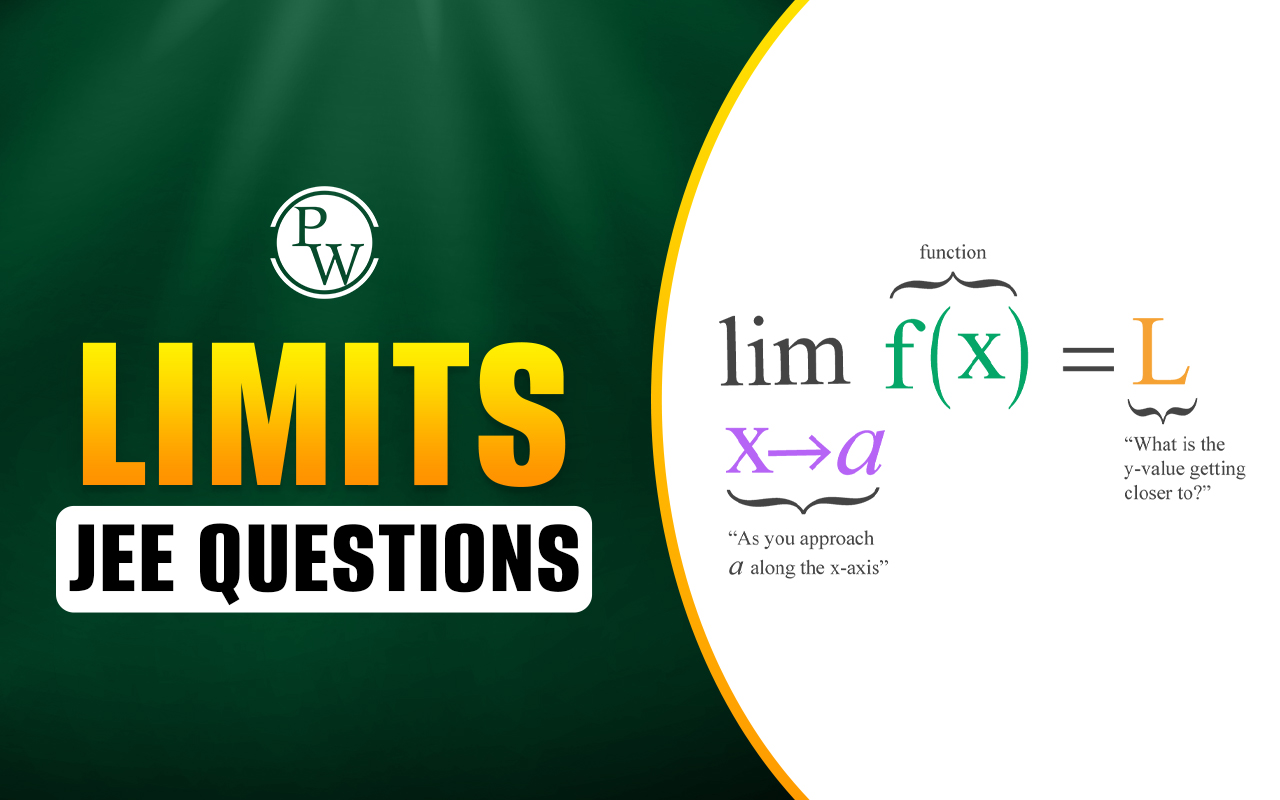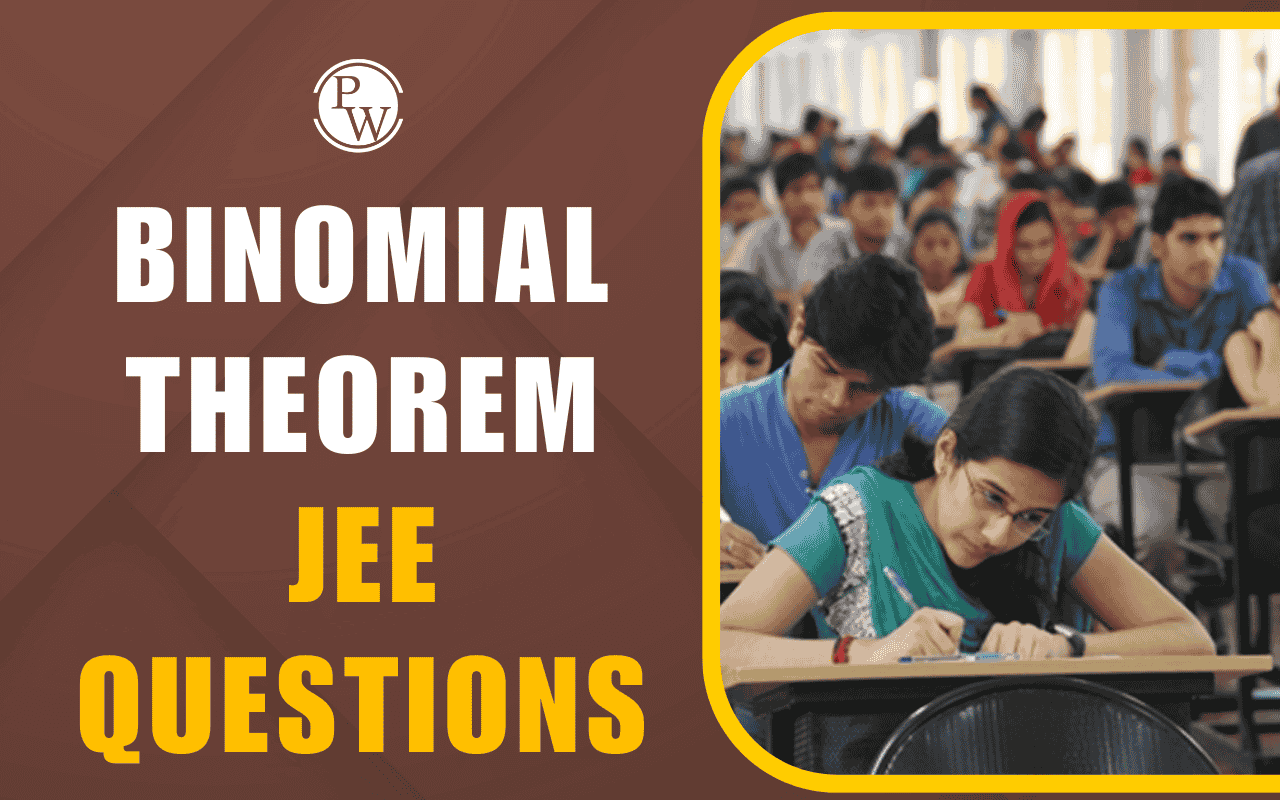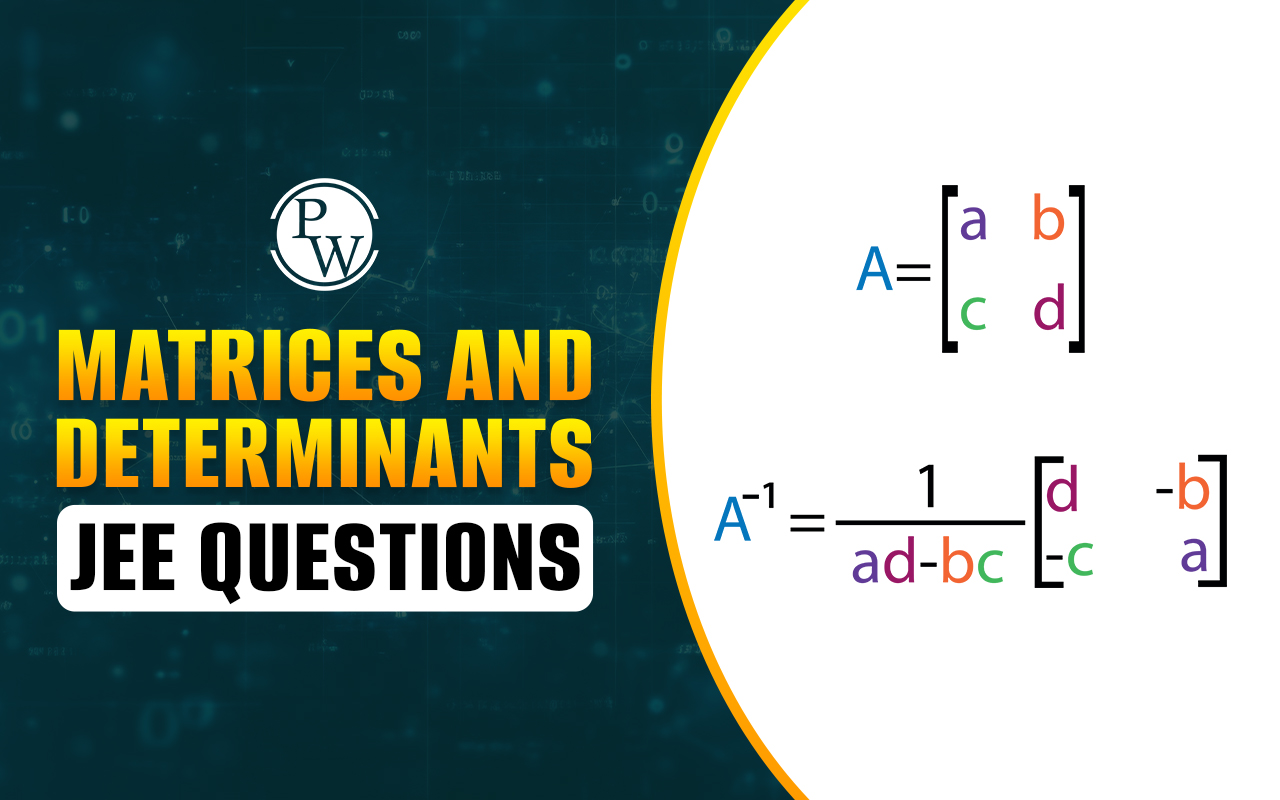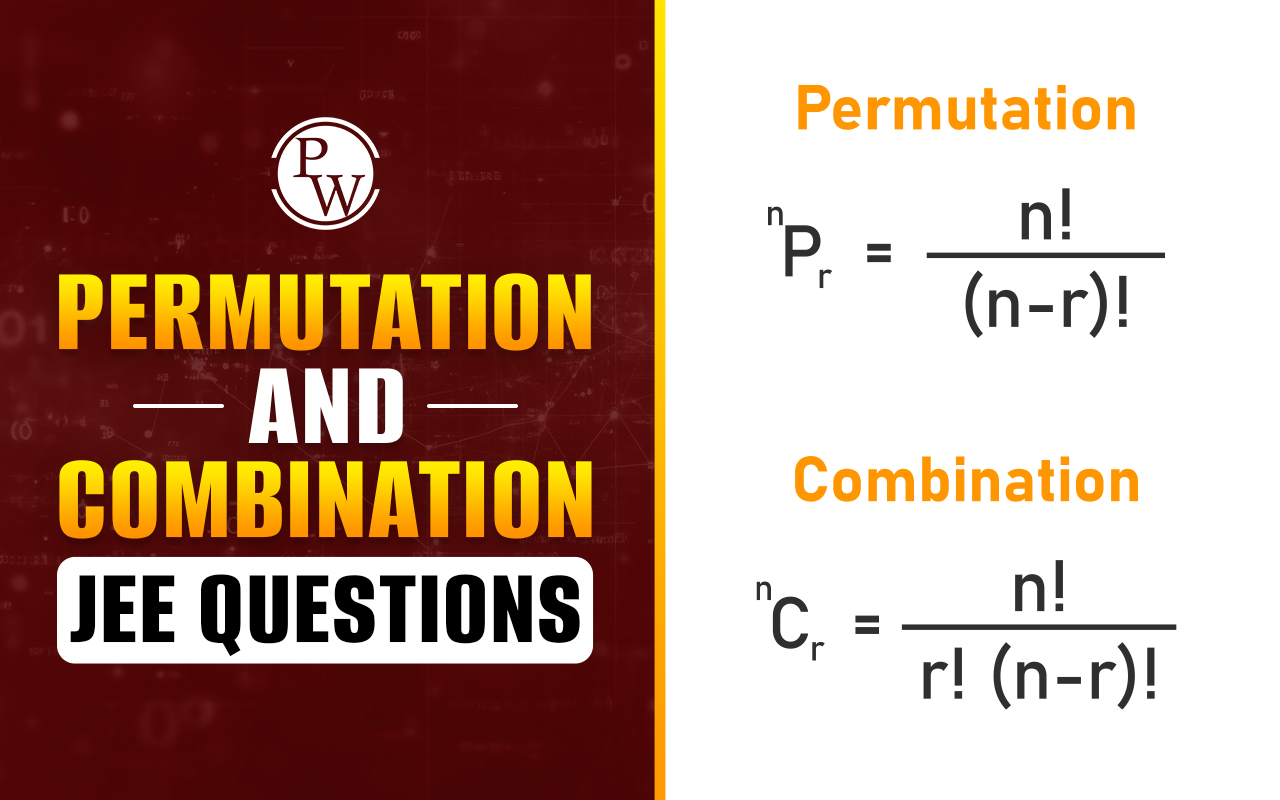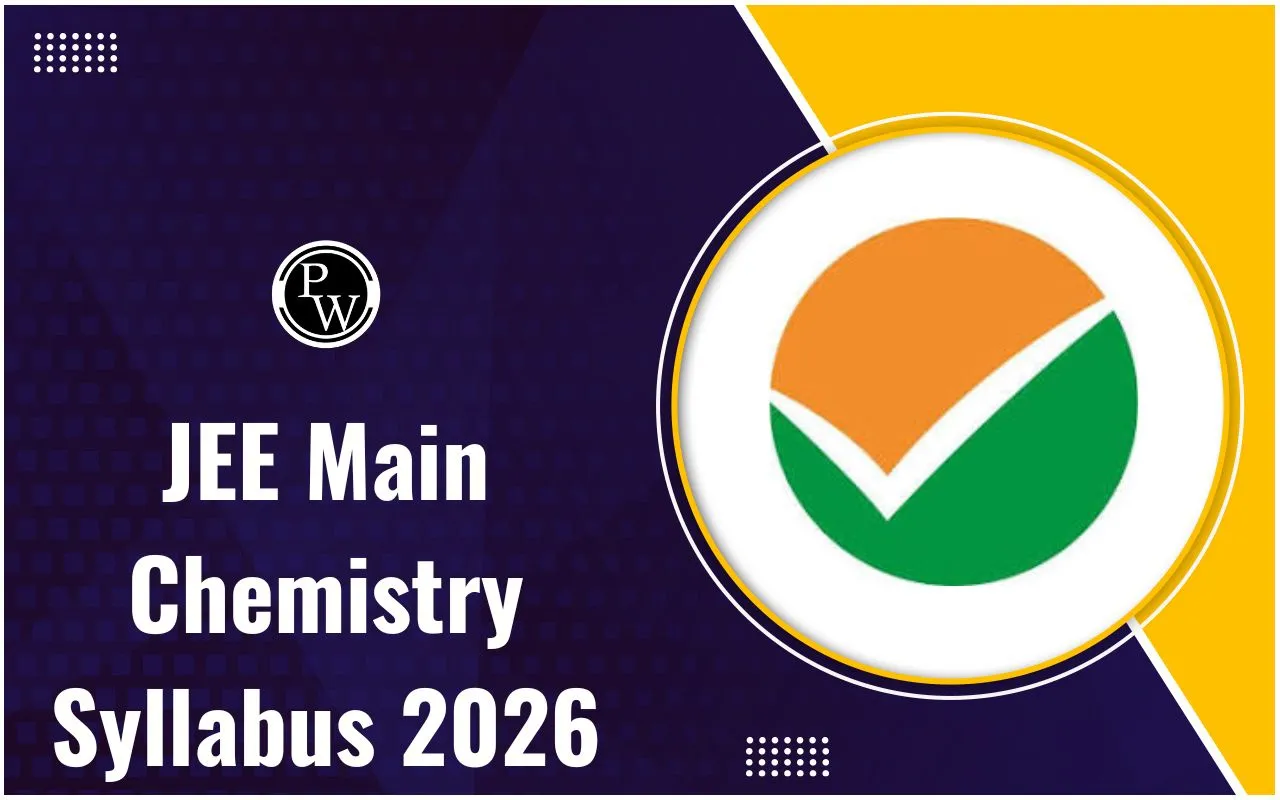
JEE Main Chemistry Syllabus 2026 is likely to be released soon by NTA on its official website, jeemain.nta.nic.in. Although the 2025 syllabus did not have any major changes for Chemistry, the removed topics from the previous year were Surface Chemistry, States of Matter, General Principles and Processes. The JEE main syllabus for chemistry covers topics like Isolation of Metals, s-Block Elements, Hydrogen, Environmental Chemistry, Alcohols, Phenols, Ethers, and Polymers.
The complete JEE Main Chemistry syllabus 2026 will detail all the topics and units covered in the JEE Main examination. It is assumed that the syllabus will be segregated into three sections:
- Section A will include Physical Chemistry
- Section B will include Inorganic Chemistry
- Section C will have Organic Chemistry
There will also be a weightage distribution for subject topics within the JEE Main 2026 Chemistry syllabus that will enable the students to target their area of study. Though for getting good marks, it is better that the candidate should study the entire syllabus.
Also Check:
JEE Main Chemistry Syllabus 2026 Overview
NTA is expected to release the JEE Main syllabus 2026 soon. Test takers can see the previous year's JEE Main Chemistry Syllabus on the official website as well, for the previous years. There will be three sections in the Chemistry syllabus: namely, Section A: Physical Chemistry, B: Inorganic Chemistry, and C: Organic Chemistry. All the subjects studied according to the NCERT syllabus of classes 11 and 12 up to the time the official syllabus of 2026 was announced with the new syllabus that will be declared in 2026 excluded, from then on, candidates are recommended to refer to the 2025 syllabus to prepare.
JEE Main Chemistry Syllabus PDF Download
Interested candidates who wish to appear in the JEE Main 2026 exam can download the Chemistry Syllabus PDF in the table below. Candidates can click on the link below and download the Chemistry Syllabus PDF.
JEE Main Chemistry Syllabus PDF
Note: PWNSAT by PhysicsWallah is a national test for Classes 5–12, offering up to 100% scholarships, cash prizes, AIR ranks, and goodies. It assesses JEE, NEET, and school-level concepts. Enroll Now.
JEE Main Physical Chemistry Syllabus 2026 (Section A)
Candidates can Visit the table given below for pointwise discussion, including all the units and topics under JEE Main Physical Chemistry 2026. Topics include Some Basic Concepts in Chemistry, Atomic Structure, Chemical Thermodynamics, Solutions, Chemical Kinetics, and more.
|
JEE Main Physical Chemistry Syllabus 2026(Section A) |
|
|
Units |
Topics |
|
SOME BASIC CONCEPTS IN CHEMISTRY |
Matter and its nature, Dalton's atomic theory, Concept of atom, molecule, element, and compound, Laws of chemical combination, Atomic and molecular masses, mole concept, molar mass, percentage composition, empirical and molecular formulae, Chemical equations, and stoichiometry. |
|
ATOMIC STRUCTURE |
Nature of electromagnetic radiation, photoelectric effect, spectrum of the hydrogen atom, Bohr model of a hydrogen atom - its postulates, derivation of the relations for the energy of the electron and radii of the different orbits, limitations of Bohr's model, dual nature of matter, de Broglie's relationship, Heisenberg uncertainty principle, elementary ideas of quantum mechanics, the quantum mechanical model of the atom and its important features, concept of atomic orbitals as one-electron wave functions, variation of ψ and ψ 2 with r for 1s and 2s orbitals, various quantum numbers (principal, angular momentum and magnetic quantum numbers) and their significance, shapes of s, p and d - orbitals, electron spin and spin quantum number, rules for filling electrons in orbitals – Aufbau principle, Pauli's exclusion principle andHund'srule, electronic configuration of elements and extra stability of half-filled and completely filled orbitals. |
|
CHEMICAL BONDING AND MOLECULAR STRUCTURE |
Kossel-Lewis approach to chemical bond formation, the concept of ionic and covalent bonds. Ionic Bonding: Formation of ionic bonds, factors affecting the formation of ionic bonds; calculation of lattice enthalpy. Covalent Bonding: Concept of electronegativity, Fajan’s rule, dipole moment, Valence Shell Electron Pair Repulsion (VSEPR ) theory, and shapes of simple molecules. Quantum mechanical approach to covalent bonding: Valence bond theory - its important features, the concept of hybridization involving s, p, and d orbitals, and resonance. Molecular Orbital Theory - Its important features, LCAOs, types of molecular orbitals (bonding, antibonding), sigma and pi-bonds, molecular orbital electronic configurations of homonuclear diatomic molecules, the concept of bond order, bond length and bond energy. Elementary idea of metallic bonding, hydrogen bonding, and its applications. |
|
CHEMICAL THERMODYNAMICS |
Fundamentals of thermodynamics: System and surroundings, extensive and intensive properties, state functions, entropy, types of processes. The first law of thermodynamics - Concept of work, heat, internal energy and enthalpy, heat capacity, molar heat capacity, Hess’s law of constant heat summation, Enthalpies of bond dissociation, combustion, formation, atomization, sublimation, phase transition, hydration, ionization, and solution. The second law of thermodynamics - Spontaneity of processes, ΔS of the universe and ΔGof the system as criteria for spontaneity. ΔG°(Standard Gibbs energy change) and equilibrium constant. |
|
SOLUTIONS |
Different methods for expressing the concentration of solution - molality, molarity, mole fraction, percentage (by volume and mass both), the vapour pressure of solutions and Raoult's Law- Ideal and nonideal solutions, vapour pressure - composition, plots for ideal and non- ideal solutions, Colligative properties of dilute solutions - a relative lowering of vapour pressure, depression of freezing point, the elevation of boiling point and osmotic pressure, determination of molecular mass using colligative properties, abnormal value of molar mass, van’t Hoff factor and its significance |
|
EQUILIBRIUM |
Meaning of equilibrium is the concept of dynamic equilibrium. Equilibria involving physical processes: Solid-liquid, liquid-gas, gas-gas and solid-gas equilibria, Henry's law. General characteristics of equilibrium involving physical processes. Equilibrium involving chemical processes: Law of chemical equilibrium, equilibrium constants (KpandKc) and their significance, the significance of ΔG and ΔG° in chemical equilibrium, factors affecting equilibrium concentration, pressure, temperature, the effect of catalyst, Le Chatelier’s principle. Ionic equilibrium: Weak and strong electrolytes, ionization of electrolytes, various concepts of acids and bases (Arrhenius, Bronsted - Lowry and Lewis) and their ionization, acid-base equilibria (including multistage ionization) and ionization constants, ionization of water, pH scale, common effect, hydrolysis of salts and pH of their solutions, the solubility of sparingly soluble salts, solubility products and buffer solutions. |
|
REDOX REACTIONS AND ELECTROCHEMISTRY |
Electronic concepts of oxidation and reduction, redox reactions, oxidation number, rules for assigning oxidation number and balancing of redox reactions. Electrolytic and metallic conduction, conductance in electrolytic solutions, molar conductivities and their variation with concentration, Kohlrausch’s law and its applications. Electrochemical cells - Electrolytic and Galvanic cells, different types of electrodes, electrode potentials including standard electrode potential, half-cell and cell reactions, emf of a Galvanic cell and its measurement, Nernst equation and its applications, relationship between cell potential and Gibbs' energy change, dry cell and lead accumulator, fuel cells. |
|
CHEMICAL KINETICS |
Rate of a chemical reaction, factors affecting the rate of reactions: concentration, temperature, pressure and catalyst, elementary and complex reactions, order and molecularity of reactions, rate law, rate constant and its units, differential and integral forms of zero and first-order reactions, their characteristics and half-lives, the effect of temperature on the rate of reactions, Arrhenius theory, activation energy and its calculation, collision theory of bi-molecular gaseous reactions (no derivation). |
JEE Main Inorganic Chemistry Syllabus 2026 (Section B)
This table provides candidates with an overview of the units and topics included in the JEE Main Inorganic Chemistry syllabus 2026. They are Classification of Elements and Periodicity in Properties, P-Block Elements, D and F-Block Elements, and Coordination Compounds.
|
JEE Main Inorganic Chemistry Syllabus 2026 |
|
|
Units |
Topics |
|
CLASSIFICATION OF ELEMENTS AND PERIODICITY IN PROPERTIES |
Modern periodic law and present form of the periodic table, s, p. d, and f block elements, periodic trends in properties of elements of atomic and ionic radii, ionization enthalpy, electron gain enthalpy, valence, oxidation states, and chemical reactivity. |
|
p- BLOCK ELEMENTS |
Group -13 to Group 18 Elements General Introduction: Electronic configuration and general trends in physical and chemical properties of elements across the periods and down the groups, unique behaviour of the first element in each group. |
|
d - and f- BLOCK ELEMENTS |
Transition Elements - General introduction, electronic configuration, occurrence and characteristics, general trends in properties of the first-row transition elements - physical properties, ionization enthalpy, oxidation states, atomic radii, colour, catalytic behaviour, magnetic properties, complex formation, interstitial compounds, alloy formation, preparation, properties and uses of K2Cr2O7 and KMnO4. Inner Transition Elements Lanthanoids - Electronic configuration, oxidation states, and Lanthanoid contraction. Actinoids - Electronic configuration and oxidation states. |
|
COORDINATION COMPOUNDS |
Introduction to coordination compounds. Werner's theory, ligands, coordination number, denticity, chelation, IUPAC nomenclature of mononuclear co-ordination compounds, isomerism, Bonding: Valencebond approach and basic ideas of Crystal field theory, colour and magnetic properties, importance of coordination compounds (in qualitative analysis, extraction of metals and in biological systems). |
JEE Main Organic Chemistry Syllabus 2026 (Section C)
See the following table for JEE Main Organic Chemistry syllabus units and topics. These are Organic Compounds containing Halogens, Purification and Characterisation of Organic Compounds, Biomolecules, Principles of Practical Chemistry, etc.
|
JEE Main Organic Chemistry Syllabus 2026 |
|
|
Units |
Topics |
|
PURIFICATION AND CHARACTERISATION OF ORGANIC COMPOUNDS |
Purification - Crystallization, sublimation, distillation, differential extraction, and chromatography-principles and their applications. Qualitative analysis - Detection of nitrogen, sulphur, phosphorus and halogens. Quantitative analysis (basic principles only) - Estimation of carbon, hydrogen, nitrogen, halogens, sulphur and phosphorus. Calculations of empirical formulae and molecular formulae, numerical problems in organic quantitative analysis, |
|
SOME BASIC PRINCIPLES OF ORGANIC CHEMISTRY |
Tetravalency of carbon, shapes of simple molecules - hybridization (s and p): classification of organic compounds based on functional groups and those containing halogens, oxygen, nitrogen and sulphur, homologous series: Isomerism - structural and stereoisomerism. Nomenclature (Trivial and IUPAC) Covalent bond fission - Homolytic and heterolytic, free radicals, carbocations and carbanions, stability of carbocations and free radicals, electrophiles and nucleophiles. Electronic displacement in a covalent bond - Inductive effect, electromeric effect, resonance and hyperconjugation. Common types of organic reactions- Substitution, addition, elimination and rearrangement. |
|
HYDROCARBONS |
Classification, isomerism, IUPAC nomenclature, general methods of preparation, properties, and reactions. Alkanes - Conformations: Sawhorse and Newman projections (of ethane), mechanism of halogenation of alkanes. Alkenes - Geometrical isomerism, mechanism of electrophilic addition, addition of hydrogen, halogens, water, hydrogen halides (Markownikoffs and peroxide effect), Ozonolysis, and polymerization. Alkynes - Acidic character, addition of hydrogen, halogens, water, and hydrogen halides, polymerization. Aromatic hydrocarbons - Nomenclature, benzene - structure and aromaticity, mechanism of electrophilic substitution, halogenation, nitration. Friedel-Craft's alkylation and acylation, the directive influence of the functional group in mono-substituted benzene. |
|
ORGANIC COMPOUNDS CONTAINING HALOGENS |
General methods of preparation, properties, and reactions, nature of C-X bond, mechanisms of substitution reactions. Uses, environmental effects of chloroform, iodoform, freons, and DDT. |
|
ORGANIC COMPOUNDS CONTAINING OXYGEN |
General methods of preparation, properties, reactions, and uses. ALCOHOLS, PHENOLS, AND ETHERS Alcohols: Identification of primary, secondary, and tertiary alcohols, mechanism of dehydration. Phenols: Acidic nature, electrophilic substitution reactions, halogenation, nitration, and sulphonation, Reimer-Tiemann reaction. Ethers: Structure. Aldehyde and Ketones: Nature of carbonyl group, nucleophilic addition to > C=O group, relative reactivities of aldehydes and ketones, important reactions such as - Nucleophilic addition reactions(addition of HCN, NH3 and its derivatives), Grignard reagent, oxidation, reduction (Wolf Kishner andClemmensen), the acidity of α-hydrogen. Aldol condensation, Cannizzaro reaction, Haloform reaction, chemical tests to distinguish between aldehydes and ketones. Carboxylic Acids: Acidic strength and factors affecting it |
|
ORGANIC COMPOUNDS CONTAINING NITROGEN |
General methods of preparation, properties, reactions and uses. Amines: Nomenclature, classification, structure, basic character, and identification of primary, secondary and tertiary amines and their basic character. Diazonium Salts: Importance in Synthetic Organic Chemistry. UNIT 19: BIOMOLECULES General introduction and importance of biomolecules. CARBOHYDRATES – Classification, aldoses and ketoses, monosaccharides (glucose and fructose), and constituent monosaccharides of oligosaccharides (sucrose, lactose and maltose). PROTEINS - Elementary idea of α -amino acids, peptide bond, polypeptides, proteins: primary, secondary, tertiary and quaternary structure (qualitative idea only), denaturation of proteins, enzymes. VITAMINS – Classification and functions. NUCLEIC ACIDS – Chemical constitution of DNA and RNA, biological functions of nucleic acids. Hormones (General introduction) |
|
PRINCIPLES RELATED TO PRACTICAL CHEMISTRY |
Detection of extra elements (Nitrogen, sulphur, halogens) in organic compounds, detection of the following functional groups, hydroxyl (alcoholic and phenolic), carbonyl (aldehyde and ketones), carboxyl and amino groups in organic compounds. The chemistry involved in the preparation of the following: Inorganic compounds, Mohr’s salt, potash alum. Organic compounds: Acetanilide, p-nitro acetanilide, aniline yellow, iodoform. The chemistry involved in the titrimetric exercises – acids, bases and the use of indicators, oxalic acid vs KMnO4, Mohr’s salt vs KMnO4. Chemical principles involved in the qualitative salt analysis: Cations – Pb²⁺, Cu²⁺, Al³⁺, Fe³⁺, Zn²⁺, Ni²⁺, Ca²⁺, Ba²⁺, Mg²⁺, NH₄⁺ Anions – CO₃²⁻, S²⁻, SO₄²⁻, NO₃⁻, NO₂⁻, Cl⁻, Br⁻, I⁻ ( Insoluble salts excluded). Chemical principles involved in the following experiments: 1. Enthalpy of solution of CuSO4 2. Enthalpy of neutralization of strong acid and strong base. 3. Preparation of lyophilic and lyophobic sols. 4. Kinetic study of the reaction of iodide ions with hydrogen peroxide at room temperature. |
JEE Main 2026 Chemistry Chapter Weightage Analysis
The chapter-wise weightage for JEE Main 2026 has been carefully analyzed based on trends observed in last 5 previous years’ question papers. Chemistry consists of three huge branches: organic, Inorganic, and Physical Chemistry. The chapter-wise description in terms of total questions and their respective weights will provide students with a complete insight into what to study.
| JEE Main Chemistry Chapter wise Weightage | ||
| S. No. | Chapter name | Chapter Weightage |
| Class 11th Chemistry | ||
| 1 | Atomic Structure | 3.34% |
| 2 | Some Basic Concepts of Chemistry | 2.82% |
| 3 | Classification of Elements and Periodicity in Properties | 1.93% |
| 4 | Chemical Bonding and Molecular Structure | 3.34% |
| 5 | States of Matter | 1.89% |
| 6 | Chemical Thermodynamics and Energetics | 3.65% |
| 7 | Redox Reaction | 1.75% |
| 8 | Equilibrium | 4.44% |
| 9 | The p-Block Elements | 1.79% |
| 10 | Some Basic Principles and Techniques: IUPAC Nomenclature | 0.10% |
| 11 | Some Basic Principles and Techniques: Isomerism | 0.27% |
| 12 | Some Basic Principles and Techniques: General Organic Chemistry | 1.20% |
| 13 | Hydrocarbons | 3.03% |
| 14 | Purification and Analysis of Organic Compounds | 1.94% |
| 15 | Hydrogen | 2.82% |
| 16 | s-Block Elements | 4.16% |
| 17 | Environmental Chemistry | 2.99% |
| Class 12th Chemistry | ||
| 1 | Solutions | 4.54% |
| 2 | Electrochemistry | 3.30% |
| 3 | Chemical Kinetics | 3.61% |
| 4 | Haloalkanes and Haloarenes | 2.65% |
| 5 | Alcohols, Phenols and Ethers | 3.54% |
| 6 | Aldehydes, Ketones and Carboxylic Acids | 5.95% |
| 7 | Amines | 4.40% |
| 8 | Biomolecules | 3.99% |
| 9 | Coordination Compounds | 5.33% |
| 10 | The p-block Elements (Group 15 to 18) | 3.68% |
| 11 | The d and f-Block Elements | 4.69% |
| 12 | Principles of Inorganic Qualitative Analysis: Salt Analysis | 0.50% |
| 13 | The Solid State | 1.72% |
| 14 | Surface Chemistry | 2.99% |
| 15 | General Principles and Processes of Isolation of Metals | 3.37% |
| 16 | Polymers | 2.06% |
| 17 | Chemistry in Everyday Life | 2.2% |
Subdiscipline-wise Question Trends in JEE Main Chemistry
Organic Chemistry had the highest number of questions in 2024, while Physical Chemistry took the lead in 2025. Despite having the fewest questions in both years, Inorganic Chemistry still held a significant weightage.
|
Year |
Organic Chemistry |
Physical Chemistry |
Inorganic Chemistry |
|
2025 |
169 questions |
176 questions |
130 questions |
|
2024 |
228 questions |
207 questions |
165 questions |
Class-wise Distribution of Chemistry Questions in JEE Main
The following table shows the distribution of JEE Chemistry questions by class (XI and XII) for the years 2024 and 2025, in both January and April attempts.
|
Year |
Class |
April Session |
January Session |
|
2025 |
XI |
90 |
113 |
|
XII |
135 |
137 |
|
|
2024 |
XI |
130 |
125 |
|
XII |
170 |
175 |
JEE Main Chemistry Preparation Tips 2026
JEE Main exam candidates should create a correct plan to improve their performance ahead of the exam. Some Preparation tips for students are
- Understand Syllabus: The JEE main chemistry Syllabus has been provided here, including all the related topics such as Physical, Organic, and Inorganic chemistry. The focus of study should be arranged according to relative weightage to save students' study time.
- Build Conceptual Clarity: Emphasise core concepts and not memorising (students' level). Understanding the underlying principles of chemical reactions and theories, as presented in these books, helps in using it very effectively for solving problems.
- Regular Practice: work on a regular basis to answer a bunch of problems and the previous year's papers. Regular practice, particularly in Organic and Physical Chemistry, will consolidate your knowledge and enhance problem-solving abilities.
- Make Summary Notes: They should prepare short notes for important reactions, mechanisms, and formulae. This is going to be of much benefit for revision before the exam.
- Use Visual Aids: Use flowcharts, diagrams, and tables( especially in Organic) to have a visual clarity of complicated points for better understanding. This will increase retention and make even hard topics easy.
- Focus on NCERT: Mostly, read the NCERT textbooks thoroughly for inorganic chemistry, and one will get a better understanding of this base level.
- Join Study Groups: Talking about subjects with classmates can improve your knowledge and integrate it into memory. Explaining concepts to others also reinforces your knowledge.
- Take Mock Tests: Solve mock tests on a regular basis to get exam-like conditions. Check your results and find out the weak areas to work on.
Study Materials For JEE Main Chemistry
Candidates can check the study materials below prepared by the faculty of Physics Wallah for the JEE Main Chemistry subject.
JEE Main Chemistry Syllabus 2026 FAQs
What topics of Physical Chemistry are important for JEE Main?
What are the crucial topics in Inorganic Chemistry for JEE Main?
What are the main sections of Chemistry in JEE Main 2026?
Is JEE Main Syllabus 2026 Released?


